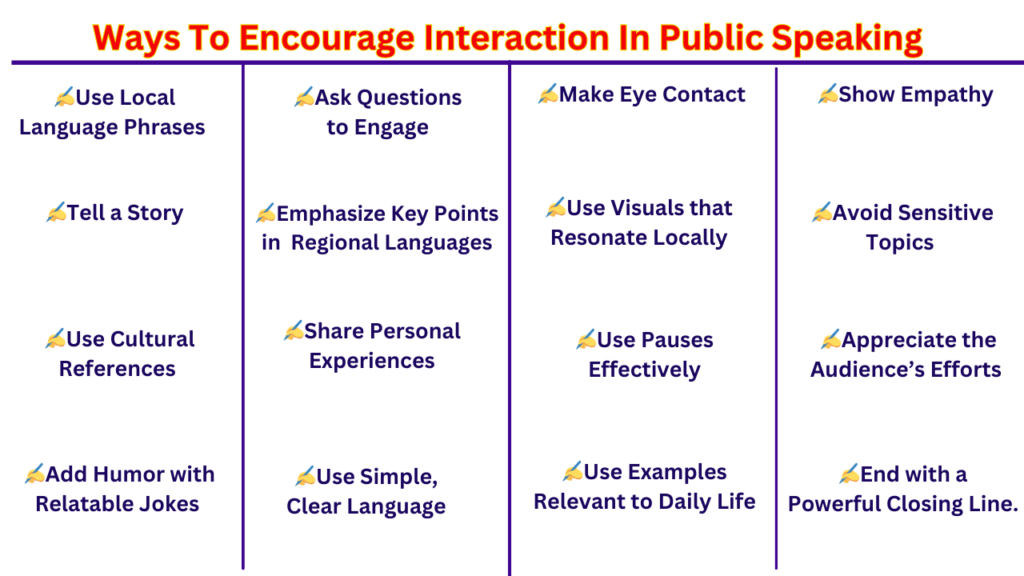Confident Public Speaking in English: Expert Tips for Clear Delivery

Introduction to Public Speaking in English
Public speaking in English entails addressing an audience, either in person or through virtual means. It’s essential for the effective communication of ideas and can have a significant impact on academic, professional, and personal aspects of life.
For those who are non-native English speakers, public speaking in English can be particularly challenging. Nonetheless, with proper strategies and adequate preparation, anyone can deliver speeches and presentations with both confidence and clarity. This blog post provides useful advice on overcoming public speaking anxiety, engaging your audience, and making a memorable impact when speaking in English.
Recognizing the Value of Public Speaking
Public speaking is an essential skill in various professional and personal situations. Whether you’re presenting at a business meeting, speaking at a conference, or participating in a social event, being proficient in public speaking can enhance your credibility, influence, and ability to clearly convey your ideas.
The Impact of Effective Public Speaking

Mastering public speaking in English, specifically, can greatly improve your ability to communicate effectively on a global scale. As English serves as the primary international language today, it allows you to connect with a wider audience. This skill is particularly valuable for career advancement, boosting confidence, and enhancing communication abilities. It provides the opportunity to share your expertise and ideas with a broader audience and can lead to new opportunities.
The Challenges of Public Speaking in English
Public speaking in English can pose distinct challenges, especially for non-native speakers. Language barriers often present difficulties with pronunciation, vocabulary, and fluency. Cultural differences can further complicate the process, as variations in body language, humor, and idiomatic expressions differ across cultures. These challenges can make the idea of delivering a speech in English intimidating, even for those who are generally proficient in the language.
Despite these difficulties, mastering public speaking in English offers substantial rewards. Effective speaking can increase confidence, foster leadership, and improve career prospects. It enables individuals to express their ideas clearly and persuasively, promoting better understanding and collaboration across cultural and linguistic boundaries. Additionally, speaking confidently in public can enhance your reputation and credibility, both locally and globally.
Tips for Building Confidence for public speaking in English
Public speaking frequently evokes a common reaction: nervousness and anxiety. Nevertheless, there are several proven strategies to help manage these emotions and deliver your speech with assurance. Confidence plays a crucial role in successful public speaking. Here are some strategies to help you cultivate and sustain confidence when speaking in English:
1. Prepare Thoroughly
Adequate preparation is crucial. By becoming deeply acquainted with your material, you not only alleviate anxiety but also enhance your presentation. Spend ample time researching and organizing your speech, ensuring that you comprehend every part thoroughly. Structure your speech in a logical manner and rehearse it several times. The better prepared you are, the more assured you’ll feel.
2. Understand Your Audience
Gaining insight into your audience allows you to tailor your speech to their interests and needs. Consider their background, knowledge level, and expectations. This understanding will help you engage with them more effectively.
3. Practice Regularly
The importance of practice cannot be overstated. Rehearse your speech repeatedly, both alone and in front of trusted friends or family. This repetition not only reinforces your material but also provides valuable feedback, boosting your confidence. Becoming familiar with your content will help you handle any unexpected issues during your actual presentation more smoothly.
4. Leverage Your Strengths
Recognize and build on your strengths as a speaker, whether it’s your ability to tell stories, your sense of humor, or your expertise on the subject. Utilizing your strengths can significantly enhance your confidence.
5. Visualize Success
Visualization is a powerful tool. Many successful speakers use this technique. Before your speech, take a few moments to close your eyes and imagine yourself delivering your presentation with clarity and confidence. Visualize your audience reacting positively. This mental practice can help create a sense of familiarity and help in overcoming public speaking anxiety.
By applying these methods, you can effectively manage nervousness and anxiety, paving the way for a confident and successful public speaking experience.
Strategies for Delivering Clear and Engaging Speeches
Crafting a coherent and impactful speech is a cornerstone of effective public speaking. To achieve this, it is crucial to present your content in a logical sequence, use straightforward language, and structure your speech effectively. A well-organized speech generally comprises a compelling introduction, a developed body, and a succinct conclusion, ensuring that the message is conveyed with maximum clarity and effect. Here are some strategies to help you deliver clear and engaging speeches in English:
1. Employ Simple and Clear Language
Utilizing straightforward language is essential for ensuring that your audience understands your message. Avoid using technical jargon or complex sentences. Instead, opt for plain language and clarify any necessary terms. This approach not only improves comprehension but also makes your speech accessible to a wider audience.
2. Organize Your Speech Effectively
A well-structured speech is more engaging and easier to follow. Start with a clear introduction, followed by a logically organized body, and finish with a concise conclusion. A strong introduction grabs attention and outlines what to expect, the body should be divided into distinct sections each addressing a specific point, and the conclusion should summarize key points and reinforce the core message, leaving a lasting impression.
3. Manage Your Pace and Tone
Finding the right balance in your speaking pace is important. Speaking too quickly can be difficult to follow, while speaking too slowly can be monotonous. Adjust your pace and vary your tone to maintain interest. Use emphasis and tone changes to highlight important points and convey emotion.
5. Incorporate Visual Aids

Visual aids like slides, charts, and videos can enhance your speech and make it more engaging. Ensure that these aids are clear, pertinent, and support your message.
Techniques for Handling Nervousness for public speaking in English
Many public speakers experience nervousness. Here are some techniques to help you manage anxiety and stay composed:
1. Breathe Deeply
Deep breathing is a simple yet effective method to calm your nerves. Practice inhaling deeply through your nose, holding your breath briefly, and then exhaling slowly through your mouth. This technique helps to relax your mind and body, making it easier to focus on your presentation.
2. Focus on Your Message
Concentrate on the importance of your message rather than your fear of speaking. Remind yourself of the significance of your topic and how it will benefit your audience.
3. Start with a Strong Opening
An engaging opening can set a positive tone and boost your confidence. Begin with an intriguing fact, a relevant story, or a powerful quote to capture your audience’s attention right from the start.
4. Practice Positive Affirmations
Repeating positive affirmations can help build confidence. Phrases such as, “I am well-prepared and capable” or “I can handle this successfully” can shift your mindset from apprehension to assurance. Incorporate these affirmations into your routine leading up to your speech.
5. Embrace Mistakes
Mistakes are a natural part of speaking. If you make an error, remain calm, correct it if needed, and move on. Most audiences are understanding and may not even notice minor slip-ups.
Engaging Your Audience for public speaking in English
Keeping your audience engaged is key to making your speech memorable. Here are some tips for effectively engaging audience in your speech:
1. Maintain Eye Contact
Eye contact helps create a connection with your audience and enhances your credibility. By making eye contact with different members of the audience, you establish rapport and show sincerity, making them more receptive to your message.
2. Use Body Language
Effective body language can enrich your message and make your speech more dynamic. Your posture, gestures, and facial expressions convey confidence and enthusiasm, helping to maintain the audience’s attention. Open and inviting body language can make your speech more engaging.
3. Encourage Interaction

Including questions in your speech can actively involve your audience. Rhetorical questions can provoke thought, while direct questions can encourage interaction. Involving the audience through questions and sharing personal stories or relevant anecdotes can make your content more relatable and memorable.
4. Tell Stories

Stories are a powerful way to engage your audience. Use relevant anecdotes and personal experiences to illustrate your points and make your speech more relatable.
5. Vary Your Delivery
Varying your vocal tone, pitch, and pace can help maintain interest. Changing your delivery style can prevent monotony and emphasize key points, keeping the audience alert and engaged.
6. Utilize visual aids and technology
Visual aids and technology can enhance your presentation. Well-crafted slides, videos, or graphics can support your message and make complex information easier to grasp. However, avoid over-relying on these tools, as excessive use can detract from your spoken message. Balance visual content with verbal delivery to keep your presentation dynamic.
Frequently Asked Questions (FAQs)
1. What is the meaning of public speaking?
Public speaking means delivering a speech or presentation to an audience with the purpose of informing, inspiring, or persuading them. In simple terms, it’s the ability to communicate your ideas clearly and confidently in front of others. Understanding the art of public speaking helps you express thoughts effectively and make an impact.
2. Why is public speaking in English important?
The importance of public speaking in English lies in its power to open global opportunities. Whether it’s a job interview, a presentation, or a conference, clear communication in English enhances your credibility, helps you connect with international audiences, and boosts self-confidence.
3. What are the main types of public speaking?
There are four types of public speaking: informative, persuasive, entertaining, and ceremonial. Each serves a different goal—for example, sharing knowledge, influencing opinions, making people laugh, or celebrating events. Knowing which type fits your situation helps you prepare better.
4. How can I overcome the fear of public speaking?
The fear of public speaking—also known as glossophobia—is very common. You can manage it by practicing deep breathing, rehearsing thoroughly, and focusing on your message instead of the audience’s reaction. Starting small, like speaking in group discussions, gradually builds your comfort level.
5. How do I improve my public speaking skills in English?
To improve public speaking, focus on structure, clarity, and emotion. Watch skilled speakers, record your own speeches, and seek constructive feedback. Enrolling in a Public Speaking course or joining a speaking club can provide guided practice and help you polish your delivery.
6. How can I get better at public speaking if English isn’t my first language?
If English isn’t your native tongue, work on pronunciation, pacing, and natural expression. Practice short speeches daily, read aloud, and listen to native speakers. The key to getting better at public speaking in English is consistency and exposure—speak as often as you can.
7. What are some good public speaking topics to start with?
When choosing Public Speaking topics, pick subjects you’re familiar with or passionate about—like personal experiences, travel, technology, or motivation. Beginners should start with simple topics that allow them to focus more on speaking confidently than memorizing complex content.
8. How can I practice public speaking effectively at home?
To practice public speaking, record yourself giving short talks, use mirrors to observe body language, and time your speech for pacing. You can also practice with friends online or take part in virtual events. Regular repetition is the best way to reduce nervousness.
9. What skills are important for successful public speaking?
Core public speaking skills include clarity of speech, body language, eye contact, tone control, and audience engagement. Good preparation and emotional connection with your listeners can make your talk memorable and persuasive.
10. Are there any courses or tools that can help with public speaking in English?
Yes! Many online platforms offer a Public Speaking course that includes lessons on confidence, delivery, and presentation design. You can also find speech-coaching apps and interactive communities to help you improve and stay motivated.
Conclusion
Mastering the art of engaging your audience through various techniques is crucial for successful public speaking. By using effective body language, eye contact, vocal variety, interactive elements, and visual aids, you can create a captivating and memorable experience for your listeners. Remember, public speaking is a skill that improves with practice and effort. Continue to refine your abilities, stay positive, and good luck!
I create content to make English learning simple and practical. If you find it helpful, consider supporting me Your contribution helps me improve my skills and bring better content for you.




You have brought up a very superb points, appreciate it for the post.
Thanks! I appreciate the effort you put in reading my post and evaluating the points I brought forth. 🙂
It’s really a great and useful piece of information. I am satisfied that you simply shared this helpful info with us. Please stay us informed like this. Thanks for sharing.
Thank you! I’m glad that you found it helpful.
Undeniably believe that which you said. Your favorite justification appeared to
be on the web the easiest factor to remember of.
I say to you, I definitely get annoyed even as folks consider worries that they plainly do not realize about.
You managed to hit the nail upon the top and defined out the whole thing without having side effect
, people can take a signal. Will likely be back to get more.
Thank you
Thank you for your lovely comment! Keep visiting the site for more…
Thank you, I’ve just been looking for info approximately this subject for a while and yours is the greatest I have discovered till now. However, what about the conclusion? Are you certain concerning the supply?
Thank you! I’m sorry but I didn’t quite understand your question. The conclusion is already there, in the article. Please elaborate.
I’m still learning from you, as I’m trying to achieve my goals. I definitely enjoy reading everything that is written on your blog.Keep the posts coming. I loved it!
Thank you for your feedback!
Hello. remarkable job. I did not anticipate this. This is a fantastic story. Thanks!
Thank you!
I am really impressed with your writing skills and also with the layout on your weblog. Is this a paid theme or did you customize it yourself? Either way keep up the excellent quality writing, it’s rare to see a nice blog like this one nowadays..
Thank you for expressing your honest opinion! I have customized it. Keep coming back for more.
Please let me know if you’re looking for a article author for your blog. You have some really good posts and I believe I would be a good asset. If you ever want to take some of the load off, I’d really like to write some material for your blog in exchange for a link back to mine. Please shoot me an e-mail if interested. Many thanks!
Thank you for your comment! As of now, I write all my posts. In future, if I consider this possibility, I’ll surely get in touch with you. Till then, keep commenting on my posts! All the best.
Awsome post and straight to the point. I am not sure if this is truly the best place to ask but do you people have any ideea where to hire some professional writers? Thank you 🙂
Thank you for your comment! Well, I’m not sure where you can get the best writers. Subscribe to my site for updates!
Great work! This is the type of information that should be shared across the net. Shame on Google for no longer positioning this post upper! Come on over and consult with my web site . Thank you =)
Thank you for your lovely feedback!
Wonderful beat ! I would like to apprentice while you amend your web site, how can i subscribe for a blog website? The account aided me a acceptable deal. I had been tiny bit acquainted of this your broadcast offered bright clear idea
You can easily subscribe by putting your mail id in the given option, at the home page. Thank you!
Would love to incessantly get updated great website! .
Sure! Subscribe for more.
Just what I was looking for, regards for posting.
You’re welcome! Subscribe for more. 🙂
I wanted to write you the very small observation to help give thanks the moment again for these pretty guidelines you’ve provided in this article. It is really remarkably open-handed with you to convey freely what exactly a lot of people might have advertised as an e-book to earn some cash for their own end, chiefly considering that you might well have done it in the event you considered necessary. Those good ideas likewise acted as the great way to understand that other individuals have similar passion just like my own to grasp a little more regarding this issue. Certainly there are lots of more enjoyable instances in the future for those who view your website.
Thanks for sharing your observation! Keep visiting the site for more.
I do believe all of the concepts you’ve offered on your post. They’re very convincing and will certainly work. Still, the posts are very short for beginners. May just you please lengthen them a bit from subsequent time? Thank you for the post.
Sure! Will keep your suggestion in mind. Keep commenting!
Your advice is spot-on and has already given me a new way to approach things. I cant wait to put these tips into action!
Thank you for sharing your feedback! Keep coming back for more.
Merely wanna comment that you have a very decent site, I like the design it actually stands out.
Thanks for your feedback!
I was suggested this website by means of my cousin. I am now not positive whether this post is written by means of him as no one else recognise such certain about my trouble. You’re amazing! Thank you!
Thanks for the feedback! Subscribe for more.
The way you connected these seemingly unrelated ideas is brilliant and opened up entirely new possibilities for me. I’ve already started exploring some of the intersections you mentioned. This kind of interdisciplinary thinking is exactly what we need more of.
Thanks for sharing your thoughts! Glad that you found the post impressive.:)
You have brought up a very superb points, appreciate it for the post.
Thank you!